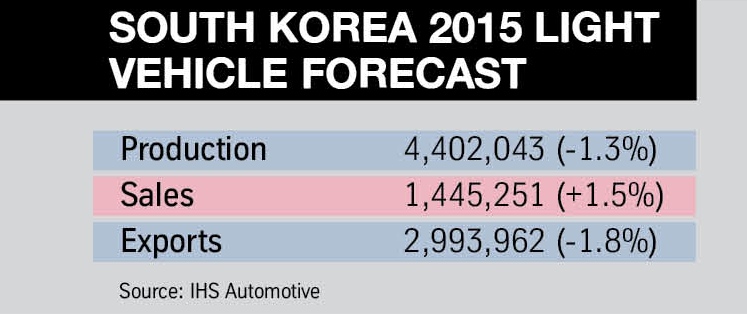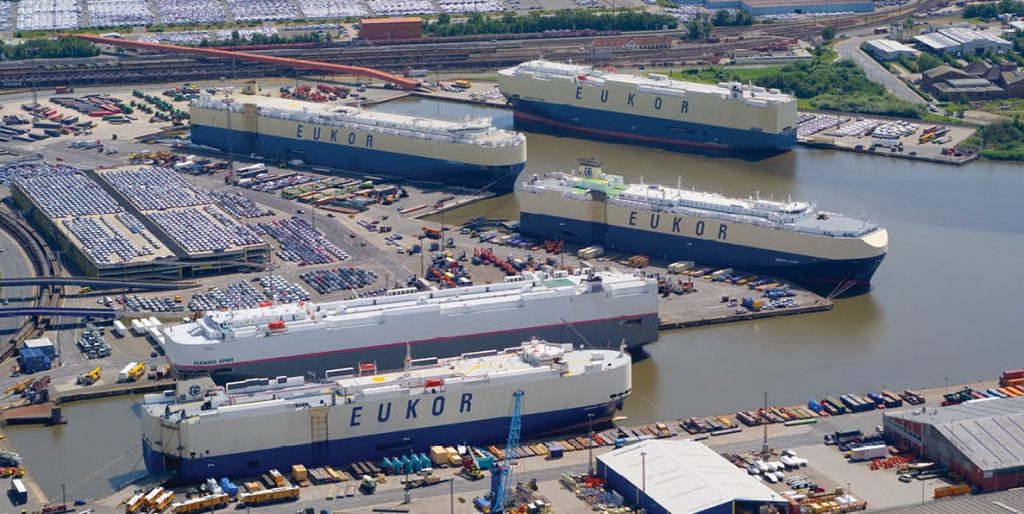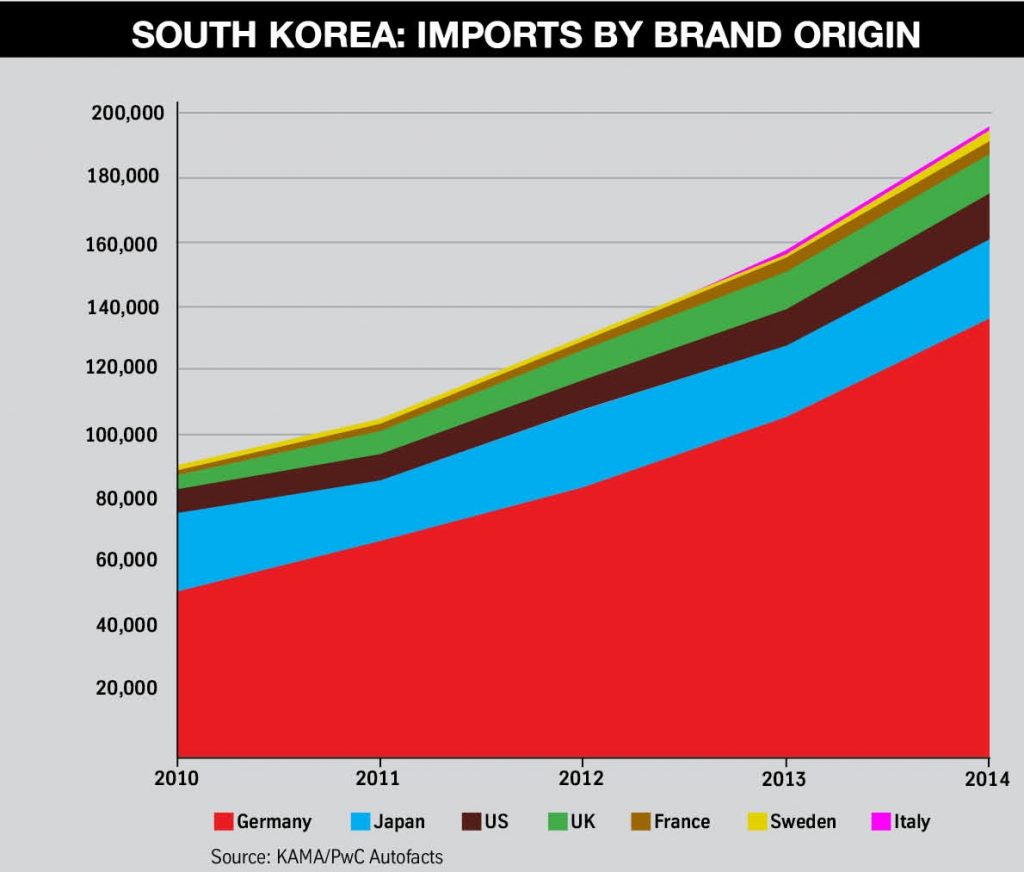 Some aspects of South Korea’s supply chain may come under pressure as logistics requires more value than just shipping constant high volumes
Some aspects of South Korea’s supply chain may come under pressure as logistics requires more value than just shipping constant high volumes
Even if South Korea is displaced from its top-three spot on the global export podium, it will remain important for logistics. The country’s vehicle logistics are notable for their speed and flexibility. At Kia’s terminal alone at Pyeongtaek port, an export manager reveals that around 55 PCTC sailings for Eukor and Glovis leave the docks each month. Eukor president Craig Jasienski notes that Kia’s proximity to export hubs in north Asia, including Japan and China, allow for high cargo utilisation and frequency of sailings.
In this story...
Although Hyundai and Kia have increased regional production, Korean exports move to nearly every country, a diversity of trade supported by free-trade agreements. Mexico, despite its many such agreements, still sends most vehicle exports north to the US and Canada, usually by rail. India and China, meanwhile, remain export minnows for vehicles compared to Korea.
South Korea is also an important exporter of heavy commercial equipment and vehicles. Hyundai Glovis is targeting more of this business for its PCTC fleet, says Sang Sok Suh. Meanwhile, with the decline in GM Korea’s exports, Höegh has been focusing on this area, including high-and-heavy, breakbulk and project cargo. According to head of commercial Trond Sjursen, the decline in Höegh’s South Korean business is expected to stabilise this year thanks to growth in these segments. “We are starting to see some traction, including in the rail business, machine tools and machinery,” he says. “We are building up a competence in moving oversized cargo out of Korea.”
Despite some decline in volume out of South Korea, there are logistics capacity constraints. Kia’s terminal at Pyeongtaek, which has capacity to park 9,000 vehicles, is nearly full.
“We need to be on our toes constantly to keep up with the capacity and be very careful with the space that we have,” says one manager, who does not wish to be named.
The question for South Korean carmakers and logistics providers is how their vehicle logistics will evolve beyond the pure capacity and cost control that characterised an era of ever-growing exports. With those days gone, and Hyundai and Kia battling profit declines, even more pressure on costs is likely. However, as brands look to push upmarket, getting a better handle on inventory, product visibility and production planning across the supply chain will be important.
Added value and better planning
Carmakers and logistics providers are already emphasising better services, including inspections, shortened vehicle holding times and better inventory planning. The head of the export administration at Hyundai Motor Company, Jwa Daesung, based at the carmaker’s Seoul headquarters, says that the carmaker’s biggest difficulty of late has been to secure stable freight space for delivery to meet export demand. However, his emphasis on addressing the issues is more about planning in the supply chain than adding trucks and ships.
“We need to strengthen our export competitiveness by optimising our production schedule based on shipping plans discussed internally,” he says.
Kia managers confirm the carmaker is trying to improve transport costs and timings to shipping centres and ports. A logistics spokesperson for Kia Motors reveals that its Korean export volume in 2014 – which at 1.24m units outpaced Hyundai by about 45,000 cars – caused Kia to move standby vehicles to temporary holding facilities. “By securing additional holding facilities in 2014 we thereby reduced our secondary transport volume,’ he says.
 Kia, together with Hyundai Glovis, has adjusted its network, including moving more volume from southern plants through the port of Mokpo, which handled 350,000 exports last year. It is also investing in a mobile-based transport management system to improve real-time tracking of cargo.
Kia, together with Hyundai Glovis, has adjusted its network, including moving more volume from southern plants through the port of Mokpo, which handled 350,000 exports last year. It is also investing in a mobile-based transport management system to improve real-time tracking of cargo.
Jong Yeon Kim, principal researcher for CJ Korea Express’s Logistics Research Institute, and responsible for the company’s automotive business, says the company has created an R&D centre specifically to build technology, engineering and IT systems for logistics. “We want to focus on add-value services rather than basic transport,” he says.
In light of capacity and efficiency demands, there is also investment in terminals. At Pyeongtaek, Hyundai Glovis will build its own export facility for up to 400,000 vehicles, including for Hyundai-Kia and high-and-heavy cargo, which is expected to start operating in 2017. Importantly, the terminal will have full PDI facilities as well as dedicated vehicle-handling and modification facilities.
“To better offer services to Hyundai and Kia, we need to invest in ports and related businesses in South Korea,” says Sang Sok Suh at Hyundai Glovis.
 Another area for development will be logistics services well beyond South Korean shores. Hyundai Glovis and shipping lines like Eukor aside, not many local Korean logistics providers have expanded globally, trailing their Japanese rivals that have followed carmakers and shipping lines over the past two decades. However, some companies are sprinting to catch up, eyeing acquisitions and business in China, North America and elsewhere.
Another area for development will be logistics services well beyond South Korean shores. Hyundai Glovis and shipping lines like Eukor aside, not many local Korean logistics providers have expanded globally, trailing their Japanese rivals that have followed carmakers and shipping lines over the past two decades. However, some companies are sprinting to catch up, eyeing acquisitions and business in China, North America and elsewhere.
One of the clearest examples is CJ Korea Express, whose large third party business includes vehicle handling and stevedoring at Korean ports including Busan, Masan and for Kia at Pyeongtaek. Part of the CJ Group conglomerate – another chaebol, albeit smaller than Hyundai Motor – the company has made no secret of its ambitions to grow globally, with automotive among its target industries. Earlier this year, CJ Korea Express made a bid to buy APL Logistics from Neptune Orient Lines, a company with strong automotive and vehicle logistics activities (the bid was eventually won by Japan’s Kintetsu World Express).
“Today we are focused on the automotive domestic market in Korea, but we are trying to expand by acquisition or joint venture into markets like China or Mexico,” says Jong Yeon Kim. “In Korea the market is very small and is dominated by Hyundai Glovis. We have to look beyond it.”
Investments by logistics providers in value-added services, as well as in extending their global operations, are important responses to the changing dynamics within South Korea. However, more may need to change if real breakthroughs in efficiency are to be made. Competition is ruthless, and price tends to dictate a lot, for example. Executives also point to tendencies for manufacturers to withhold information, and to a general lack of trust.
“The market is generally very closed, and by Korean conventions companies don’t usually want to share much of their real-time or advanced information,” says CJ Korea’s Kim. “That makes it difficult to optimise costs.”

This divide is not uncommon across the global automotive sector, but may be even more entrenched by Korean hierarchies and the chaebol business tradition. Hyundai Glovis benefits from long-term contracts with Hyundai and Kia, for example, and is often the gatekeeper for the group’s logistics, subcontracting services to providers while it simultaneously competes with some logistics companies in business areas ranging from warehousing to ocean shipping.
Hyundai Motor also maintains a stake in Eukor (which was once Hyundai Merchant Marine’s car carrier division), and Hyundai-Kia exports are split roughly 60% to Eukor, and 40% to Glovis, making a good deal of services “untouchable” to non-affiliated providers, according to Höegh’s Trond Sjursen.

In many cases, however, logistics providers take on subcontracted services from Hyundai Glovis, making it, for some companies, both “a customer and a competitor”, as CJ Korea’s Kim and Höegh’s Sjursen both describe it. For example, Höegh might pick up subcontracted shipping routes from Glovis in some lanes, or potential terminal business, even while both may be going after non-Hyundai Motor, high-and-heavy cargo. “It is a love-hate relationship,” adds Sjursen. “Glovis is a good partner and good customer, but at the same time they are in stone-hard competition with us.”
While Hyundai Glovis enjoys captive volumes, it does not necessarily gain more trust or inside information from its parent group, at least in Korea. Suh admits that there is a limited amount of shared sensitive or strategic information between the companies. “Hyundai and Kia don’t want to open their data even to Hyundai Glovis,” he says. “We have no participation in their strategy and planning.”
Furthermore, Glovis’s status within the Hyundai Motor Group can make other carmakers in South Korea reluctant to work with it. “For serving other OEMs, being part of the Hyundai Motor Group can be a disadvantage, especially in Korea, where other brands might be wary of working with Hyundai Glovis,” admits Suh. “We are pushing to penetrate into this business, but it is hard.”
In Korea at least, this reluctance cuts both ways for Glovis. Suh confirms that it will target other industries and third parties at a new terminal it will build in Pyeongtaek more so than it will go after other passenger car brands, for example. “Our ambitions are instead to work with other businesses and industries like heavy manufacturing,” he says.
Outside South Korea, however, serving other passenger car brands appears to be less of a conflict for Glovis: its port processing arm in the US (GAPS) has several carmaker clients, while its recent acquisition of Adampol in Europe was partly aimed at gaining business with other marques. A large share of the pure-car-and-truck carrier division’s volume also comes from third parties (although this is not always passenger car brands).

These distinctions might suggest that as Hyundai and others become more international and face more competition at home, there may be cultural and business changes within South Korea. Suh points to signs that Hyundai Motor Group’s own focus on logistics is becoming more strategic.
“When the cars sold quickly, logistics didn’t matter as much,” says Suh. “But as sales are slower, logistics is more important than ever to the Hyundai Motor Group, and we are increasingly looking for synergies in moving the vehicles in ports and at sales compounds.”
With such changes, Korean taboos may be broken. For example, as Hyundai and Kia build and export more from regional plants, such as in India and Europe, new relations are forged. Trond Sjursen says that, although Glovis is a “fierce competitor”, Höegh has been able to capture some of these cross-flows on a Glovis bill of lading. “This has been a success for us, and has helped us forge a close relationship with Glovis that we value very much,” he says.
 As Hyundai-Kia build and export more from regional plants in locations such as Europe (above), competitive boundaries are being crossed
As Hyundai-Kia build and export more from regional plants in locations such as Europe (above), competitive boundaries are being crossedCraig Jasienski says that Eukor and Glovis work together in handling Hyundai-Kia exports, but the shipping line has also increased its own cargo and brand diversification, including for imported vehicles to South Korea.
And as logistics firms like CJ Korea Express extend their reach, its executives realise that the company needs to overcome competitive boundary lines, including working with the likes of Glovis. “We cannot evade Glovis, but we can find some synergies,” Jong Yeon Kim says. “For example, maybe if we acquire or partner with other companies in India or Mexico, it could be us w ho handles the vehicles that arrive after they move on Glovis vessels.”
Such opening up would no doubt depend on Hyundai Glovis and its parent company as much as others, but these are signs of progress – even if slow – towards new openings and approaches across the South Korean industry. That will be important if its companies are to see further miracles on the Han River and beyond.
Click here to read part 4 in our South Korea series, "Hyundai Glovis: Full steam ahead". (Published July 15th)
Click here to read the full list of stories in this special section.





































